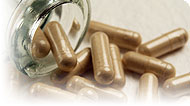Penn Herb Wellness Guide
ProanthocyanidinsFind Products

How to Use It
Flavonoids (proanthocyanidins and others) are a significant source of antioxidants in the average diet. Proanthocyanidins at 50100 mg per day is considered a reasonable supplemental level by some doctors, but optimal levels remain unknown.
Where to Find It
Proanthocyanidins can be found in many plants, most notably pine bark, grape seed, and grape skin. However, bilberry, cranberry, black currant, green tea, black tea, and other plants also contain these flavonoids. Nutritional supplements containing proanthocyanidins extracts from various plant sources are available, alone or in combination with other nutrients, in herbal extracts, capsules, and tablets.
Possible Deficiencies
Flavonoids and proanthocyanidins are not classified as essential nutrients because their absence does not induce a deficiency state. However, proanthocyanidins may have many health benefits, and anyone not eating the various plants that contain them would not derive these benefits.
Copyright 2026 TraceGains, Inc. All rights reserved.
Learn more about TraceGains, the company.
The information presented by TraceGains is for informational purposes only. It is based on scientific studies (human, animal, or in vitro), clinical experience, or traditional usage as cited in each article. The results reported may not necessarily occur in all individuals. Self-treatment is not recommended for life-threatening conditions that require medical treatment under a doctor's care. For many of the conditions discussed, treatment with prescription or over the counter medication is also available. Consult your doctor, practitioner, and/or pharmacist for any health problem and before using any supplements or before making any changes in prescribed medications. Information expires December 2026.


